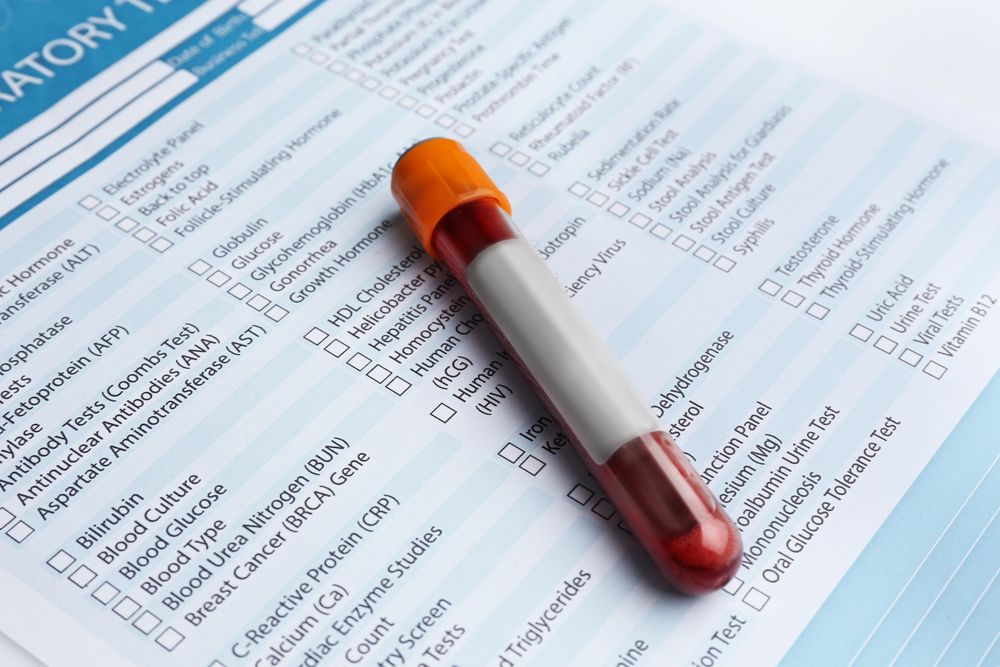A complete blood count is often performed as part of a routine health examination, to assess general health, or to diagnose or monitor specific conditions, such as anemia, infections, blood clotting disorders, and certain forms of cancer.
Red blood cells (RBC):
Number of red blood cells in a given volume of blood. Red blood cells contain hemoglobin, a protein that carries oxygen from the lungs transports to the rest of the body. This determination is not determined as standard.
Hemoglobin (Hb):
The amount of hemoglobin in the blood, which is an indication of the ability of the blood to carry oxygen. Low hemoglobin levels can indicate anemia.
Hematocrit (Hct):
The percentage of the blood that is made up of red blood cells. indicates how much space the red blood cells take up in the total blood volume. The hematocrit is always reported!
White blood cells (WBC):
Number of white blood cells in a given volume of blood. White blood cells are involved in the immune system and protect the body against infections.
Differential White Blood Cell Count (WBC Diff) (NOT performed in this study):
Indicates the percentage of different types of white blood cells, such as neutrophils, lymphocytes, monocytes, eosinophils and basophils. This can help identify certain infections or inflammatory conditions.
Thrombocytes (platelets):
Number of platelets in a given volume of blood. Platelets are essential for blood clotting and stopping bleeding.






Compleet bloedbeeld (CBC)
Markers:
Bloedbeeld
You do not need to be fasting for this blood test.
Pay close attention to what is and is not specified, this is described in the text!
The accuracy of the test for Compleet bloedbeeld (CBC) is conducted through ISO-certified laboratories. The accuracy of a test method is expressed in terms of specificity and sensitivity. However, the most important aspect is that the results are interpreted and accepted among general practitioners and hospitals. This is the case with our venous samples. Mutual acceptance may not always be present due to potentially reduced reliability with a capillary sample.
Most tests generally take 24-48 hours. Tests that go through an LC-MS method generally take longer, think about an average of 3-7 working days. Additionally, it also depends on the location. Some locations do the analysis themselves and others outsource it to another lab.
Interpreting the results of Compleet bloedbeeld (CBC) is not always easy and should be seen in the broader picture, along with anamnesis and physical examination. In the doctor's advice section, the query in which you can already outline your complaints is taken into account, otherwise, the results are interpreted in conjunction with the other results. If necessary, the doctor can call to ask about physical abnormalities. You don't have to interpret the results yourself because there is always advice and explanation from the doctor.
If the results of the test for Compleet bloedbeeld (CBC) are clinically significantly abnormal, the doctor will contact you by phone. If you are not reachable, you will receive an email. This includes advice and an explanation of the abnormal results and what you can do about them. If you need a prescription or referral, we can help with that.
The costs of Compleet bloedbeeld (CBC) can be found on the product page. Depending on your insurance and additional packages, you may be reimbursed for these costs for Compleet bloedbeeld (CBC). For example, tests for IVF treatment are often reimbursed. After your order, you will receive an invoice that you can submit to your insurance.
The ordering process is easy. You can add a Compleet bloedbeeld (CBC) test or the tests you want to your shopping cart. In step two, you fill in your details and pay. Then you will receive an email confirmation and you can go to a collection location. After you have been there, you will receive the results of the Compleet bloedbeeld (CBC) test in your Portal.
We are certified-ready according to the NEN 7510 and 7512 standards for secure data transfer in healthcare. The Portal is secured with two-factor authentication. Your data is also encrypted. We do not send the results of Compleet bloedbeeld (CBC) to third parties without permission, not even to your general practitioner without your consent.
The blood test for Compleet bloedbeeld (CBC) must take place at one of the collection locations we provide. At certain locations, it is possible for a phlebotomist to come to you. You can indicate this during checkout. An appointment will then be made as soon as possible to come to your home.
You can easily make an appointment for Compleet bloedbeeld (CBC) blood test after your order in your Portal. You can visit almost daily in all major cities in the Netherlands. In smaller cities, you can visit on certain days. At certain locations, it is also possible to visit on weekends.
An interpretation by a doctor or an explanation is included in the Compleet bloedbeeld (CBC) test. The explanation takes into account the query that you can specify in your Portal after ordering.
For blood tests, we always use venous sampling. This is the gold standard for blood collection. Over-the-counter tests, such as a finger prick test, use the capillary route for blood collection. These do not always give the same results and the accuracy depends on how, where, and with which technique the collection is done. The advantage, of course, is that the test is easier and less painful to take.
You can always pay with iDeal and credit card (VISA, Mastercard, and Amex). This also includes Apple Pay. The phlebotomists at the collection location cannot accept cash payments.
The results of Labplusarts can be shared with your general practitioner at your request. However, you can also easily arrange this yourself by downloading the result in PDF format. Because we use comparable test methods as the general practitioner, the results are interchangeable and comparable so that comparisons can be made well.
EUR
74,00
Validatie door artsen
Uitslag binnen: 24 - uur
?
Need help?
Bel naar 085-0043917 voor advies of chat via Whatsapp
Related products
Lab test without a referral at 350+ locations
Eenvoudig bloedprikken waar en wanneer het jou uitkomt.